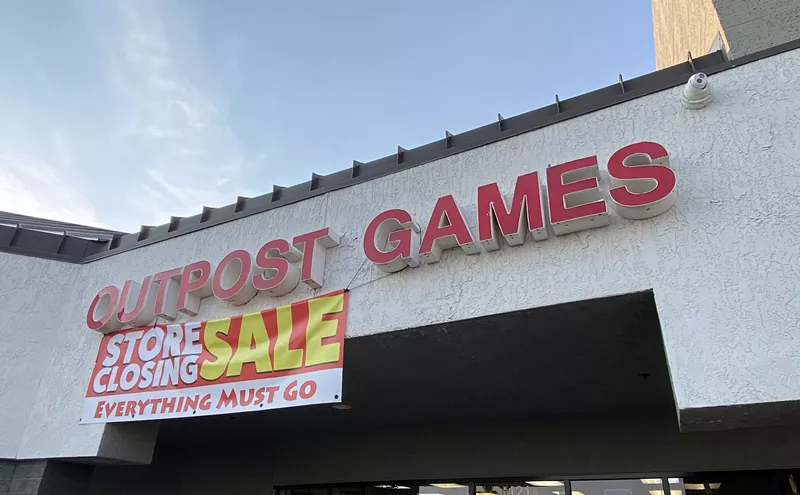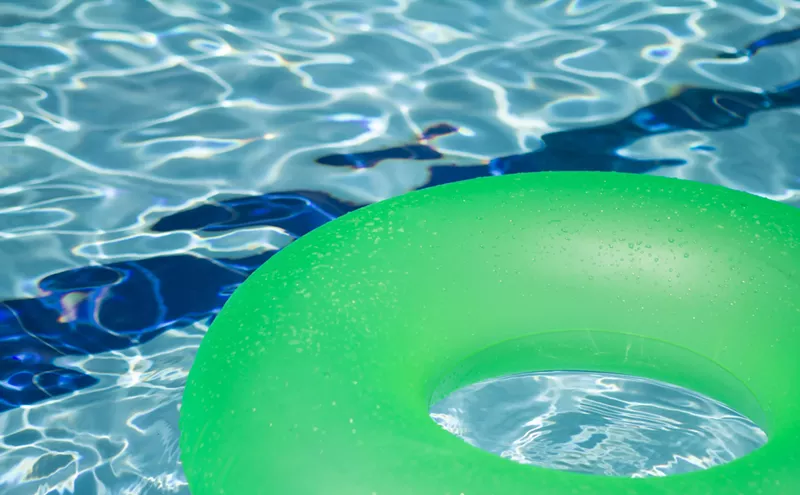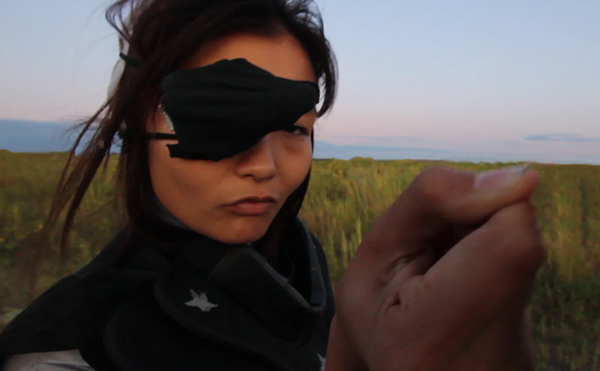Mary Shelley’s 1818 novel was adapted for the stage by 1823, and for the movies, in a version by Thomas Edison starring Charles Ogle as the Monster, by 1910. But the image conjured up by the name Frankenstein for most of us is the classic bolt-necked, greenish-skinned beanpole with the coffee-can-shaped skull, mimed so memorably by Boris Karloff in the original 1931 Universal movie version (he got to growl a few words in 1935’s The Bride of Frankenstein, but was inarticulate again in 1939’s The Son of Frankenstein).
With last year’s ridiculous but not dull revisionist buddy-picture version Victor Frankenstein out on Blu-ray this week, let’s take note of some of the countless other pop-culture permutations of this indestructible patchwork man. Here are a few that come to mind as the weirdest:
The Irish Frankenstein
This cartoon, which appeared in Punch in the wake of 1882's Phoenix Park Murders, allegorically depicts the Irish as monstrous terrorists, though, being a "Frankenstein," it also implies that their monstrousness was ultimately England's creation. It was the work of the great illustrator John Tenniel, far better known for his pictures for Alice in Wonderland than for this ugly and reactionary, though beautifully-drawn, smear.
Tenniel was fond of this device when depicting Irish revolutionaries, however. In 1870 he offered the "Irish Caliban," comparing opponents of English rule to Shakespeare's subhuman beast, and in 1885, Tenniel depicted Irish nationalist leader Charles Parnell as the "Irish Vampire.”
Dell Frankenstein
This was one of three attempts by Dell Comics, in 1966, to spin the movie monsters then in a Renaissance of popularity into comic-book superheroes. The other two were Dracula and The Werewolf. None of them caught on; all three ran just three issues each.
The title character of Frankenstein was the super-strong Monster, revived a century after his creation. Taking the impenetrable alter-ego “Dr. Frank Stone” and donning a handsome mask to hide his green-skinned face, Our Hero does battle with the nefarious likes of the tiny, bald-pated Dr. Freek.
Frankenstein Jr.
Another attempt, this one slightly more successful, at Frankenstein as a superhero was this Hanna-Barbera cartoon from the mid-'60s. The Frankie in question was a giant flying robot who, under the guidance of his young pal Buzz, battled bizarre villains for truth, justice, and so forth.
The title character was rumblingly voiced by Ted Cassidy — Lurch on The Addams Family, and Ruk the robot on Star Trek’s “What Are Little Girls Made Of?” — who would have made a great Frankenstein in live action. Cassidy also provided the vocalizations for the Hanna-Barbera cartoon Godzilla, which presumably makes him the only actor ever to have played both of these monsters.
Giant Japanese Frankenstein
This is not to say, however, that the Frankenstein Monster has never been a Japanese-style kaiju. The 1965 Toho effort known in the U.S. as Frankenstein Conquers the World concerns a boyish giant generated by the presence of the Frankenstein Monster’s unstoppable heart, stored at Hiroshima during the explosion of the atom bomb (the Nazis had given the still-ticking organ to the Japanese as the end of WWII neared).
At the film’s climax, the hapless mega-Frankie scraps with the Godzilla-ish reptilian monster Baragon, hence the Japanese title Furankenshutain Tai Chitei Kaiju Baragon. The movie is familiar to legions of insomniacs, but not everybody knows it spawned a sequel.
A few years ago, the Oscars show featured talking heads of famous people discussing their earliest movie memories. Brad Pitt recalled being taken to see a movie featuring “a good Gargantua and a bad Gargantua,” and that the good Gargantua had to sacrifice himself at the end. He’s thinking, of course, of the 1966 Japanese kaiju film known in the US as War of the Gargantuas, but titled Furankenshutain no Kaiju: Sanda tai Gaira. Released in the US in 1970, it’s vaguely a sequel to 1965’s Frankenstein Conquers the World.
The character who inspired Mr. Pitt with his selflessness was Sanda, the brownish, mountain-dwelling “Good Gargantua,” who does battle for humanity's sake with his greenish, sea-dwelling, people-gobbling brother Gaira in that movie. I was taken to it by my long-suffering mom, for all I know on the same day as Pitt (he’s only about a year younger than I am, which is probably why I’m often mistaken for him). I remember it spooked me slightly more than the Japanese monster pictures usually did. Accidental byproducts of the Frankenstein-ian experiments in the earlier film, these shaggy anthropoids with their ugly ogre-ish faces and their Cain and Abel dynamic, plus the goriness of Gaira’s eating habits, combined to make this one grimmer and nastier than the typical Godzilla fare.
Also, there’s the matter of the horrible song in the clip above, which has been occupying space in my cranium for four decades.
Twizzler Frankie
The Frankenstein monster has been used as a commercial pitchman many times, of course. But it’s doubtful that any Frankenstein ad was ever quite as visually beautiful (or odd) as this one, for Twizzlers.
It’s one of several TV spots in which pop cultural icons take shape from the red cables of deliciousness. The King Kong and Star Trek ones are on the marvelous side, too.
T-Mobile Frankie
It’s just as possible that no Frankenstein commercial has ever been as funny as this one. Here the Monster’s supposed mental limitations are used to demonstrate the ease with which the superiority of the T-Mobile phone over the competitor’s phone may be perceived. But the Monster is clearly aware that he’s being condescended to, and clearly irked by it. His civil yet nettled line readings are flawless.
The Monster also takes offense at the mad scientist’s casual use of… well, of the M-word. Sorry, I guess I should have said that the Creature is offended.
Pythonstein
In the classic Monty Python sketch “The Dull Life of a City Stockbroker,” John Cleese briefly plays the Frankenstein Monster, pummeling people queued up to catch the bus. Best touch: the Monster’s dejected reaction when he fails to strike down the stockbroker.
Blackenstein
Some of the “blaxploitation” horror pictures of the '70s aren’t bad at all. Blacula, in particular, for all its datedness, has some truly macabre scenes, most memorably the fate of poor Elisha Cook, Jr.
1973’s Blackenstein, not so much. Sometimes helpfully subtitled The Black Frankenstein in case we, you know, didn’t get the idea, this one features a hulking Monster (Joe De Sue), stitched back together after losing his limbs in Vietnam, whose traditional Frankie flat-top head shape is adorned with an afro. His victims spend a lot of time backing away in terror when they could be running away in terror.
Frankenstein Island
When an experienced Z-movie buff hears the name “Jerry Warren,” it’s unnecessary to apply the adjective “strange” to the movie in question. Or the adjective “dreadful,” for that matter.
Warren, director of the stuff like Teenage Zombies and The Incredible Petrified World, makes Ed Wood look like David Lean. But even those acquainted with Warren’s work may not be prepared for the jaw-dropping imbecility of Frankenstein Island, 1981 swan song, and perhaps his magnum opus. It’s about a quartet of balloonists marooned on an island inhabited by seductive native women and a modern-day Frankenstein, Sheila (Katherine Victor), who’s making an army of zombie slaves in black turtlenecks and cool shades.
Some real Hollywood veterans like Robert Clarke, Cameron Mitchell, Andrew Duggan and Steve Brodie were in this one. Even the great John Carradine pops up as the Ghost of the Old Man Frankenstein, appearing now and then to spew an incomprehensible prophecy concluding with the repeated phrase “THE POWER! THE POWER! THE POWER!” in his magnificent basso.
Frankenstein Island probably qualifies as the all-time strangest Frankenstein movie. But by no means is it the strangest Frankenstein monster. When he finally makes his big entrance, near the end of the movie, he’s fairly conventional.
All the same, this movie will certainly make you say “What the…”
Fucking Frankenstein
You read it right, Fucking Frankenstein, a novel by Mary Wollstonecraft Shelley and “Mr. Matt Allen.” The latter scribe’s contribution consisted of adding the word “fucking,” or “fuck,” to the text of the iconic 1818 classic, more than a thousand times.
This is a real (albeit self-published) book. No kidding.
A sample:
“Oh fuck! No fucking mortal could support the horror of that countenance. A fucking mummy again imbued with animation could not be so hideous as this wretch. I had gazed on him while unfinished; he was ugly then; but when those muscles and joints were rendered capable of fucking motion, it became a thing such as even Dante could not have fucking conceived.
I passed the fucking night wretchedly…”
I didn’t want trees to die so that I could have a copy of Fucking Frankenstein, so I bought the Kindle edition back in 2010. Now I rather wish that I’d sprung for the paperback, because it appears now to only be available in paperback on Amazon, with prices starting at $33.12.
Irritating as I find this ridiculous stunt — a low point, perhaps, in the vogue started by Pride and Prejudice and Zombies — having given it a read I must nonetheless acknowledge that it does demonstrate the enduring power both of the original Frankenstein, and also of the word “fuck.” Implied in the choice of this particular novel for this treatment — as opposed to, say, Wuthering Fucking Heights — is the idea of revivification, of shocking life back into something dead. But Shelley’s Frankenstein most certainly does not need to be resuscitated. Despite the datedness of her gothic style and dilatory pace, despite the labored clumsiness of some of her plotting, Shelley’s prose hums with terrible and pitiless life. It certainly didn’t need everyone’s favorite scurrility to “help” it.
Yet somehow the word, in all its life-avowing intensity, seems very comfortable therein. It’s sort of like adding jalapenos to Havarti cheese: They aren’t needed, but they do add a certain zing.
It really is a wonderful word, when you think about it. The repetition of it here made me remember something that I once read, attributed to Auden or Robert Graves or somebody of that sort — that in the British army, the word “fuck” was so ubiquitous that it had no meaning; it merely signaled the approach of a noun.
But, and I can’t believe I read the fucking thing closely enough to say this, but, I don’t think Mr. Matt Allen did his job as well as he could have. Not to sound like an actor, but at times I felt like I could have done it better. I think I could have found more apt places to insert “fucking” into Frankenstein, and also simply more places. At times Allen seems like he’s being stingy — having set myself this absurd task, I would have been more generous with the fucking.
By the way, I once pitched the idea of reviewing this (using asterisks or brackets or something) to an editor at a daily for whom I’d done many book columns. Normally an up-for-anything type of guy, he answered me thusly: “I gotta tell ya … No fucking way.”












